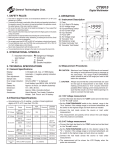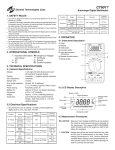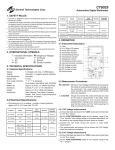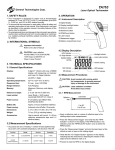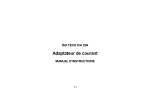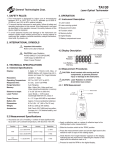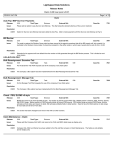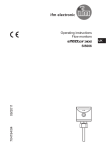Download User`s Manual (PDF 329K) - General Technologies Corp.
Transcript
CT8022 General Technologies Corp. Autorange Ergonomic Handheld Multimeter 1. SAFETY RULES • This meter is designed for indoor use at temperatures between 0°C to 40°C and • • • • • • • • • altitudes up to 2,000m. To ensure that the meter is used safely, follow all safety and operating instructions in this operation manual. If the meter is not used as described in this operation manual, the safety features of this meter might be impaired. Do not use the meter if the meter or test leads look damaged ,or if you suspect that the meter is not operating properly. When using the instrument, keep your fingers behind the finger guards on the plastic casing and probes. Disconnect the live test lead before disconnecting the common test lead. Make sure power is off before cutting, desoldering, or breaking the circuit wires. Small amounts of current can be dangerous. Do not apply more than 600 VDC or 600V AC rms between a terminal and ground. To avoid electrical shock, use CAUTION when working above 60V DC or 25V AC rms. Such voltages pose a shock hazard. Never make measurements with the battery cover off. To avoid electrical shock or damage to the meter, do not exceed the input limits. 2. INTERNATIONAL SYMBOLS Important information see manual AC DC Dangerous Voltages Continuity Ground Double Insulation Function Resistance Diode Test Range Accuracy Input Impedance Remarks Overload Protection 400Ω, 4kΩ, 40kΩ,400kΩ 4MΩ 1.0%+2 - 1.2 mA max. test current 250 Vp-p 40 MΩ 1.5%+2 - 0.47 mA max. Test current 250 Vp-p Test Voltage: 3.2 V Max. 250 Vrms Test Current:1.0± 0.6mA 4. OPERATION 4.1 Instrument Description 1) Case 2) 3-3/4 Digit LCD display 3) ON/OFF and Range switch 4) Function switch 5) Fixed test lead with probe 6) Fixed probe tip and fuse cap 7) Battery cover 8) Display hold push button (back of the unit) 9) Probes cups 10) Alligator clip � 3. TECHNICAL SPECIFICATIONS � � 3.1 General Specifications Display: Polarity: Zero adjustment: Sample rate: Over range indication: Power: Battery life: Dimension: Weight: Accesories: �� 3-3/4 digits LCD, max. of 3999 display with decimal point and engineering units Automatic, (-) negative polarity indication Automatic 0.5 Sec. reading “OL” is displayed 9-volt battery type NEDA 1604, IEC6F22 Approx. 50 hours. (w/ alkaline batteries) 141 x 69 x 36 mm. Approx. 160g (including battery). User’s Manual, Alligator Clip, Probes Cups and 9V alkaline battery Function Range Accuracy Remarks DC Voltage 4000mV, 60V 600V 0.8%+1 10 MΩ - 600 Vp-p AC Voltage 4000mV, 60V 600V 1.2%+3 10 MΩ 40~400Hz 600 Vp-p DC Current 40 - 400 mA 1.2%+3 - - 400 mA/ 250V Fuse AC Current 40 - 400 mA 1.2%+5 - 40~400Hz 400 mA/ 250V Fuse MK� mVA �� � � 4.2 Display Description ������� ������� �� ��� ����� ������ ���� ���� ���������� ������ ������ �� �� 8.8.8.8 • The mark Overload Protection �� � � �� Input Impedance �� 8.8.8.8 3.2 Electrical Specifications next to the probe tip, is a warning that the input voltage should not exceed the indicated values. This is to prevent personal injuries and damage to the internal circuitry. • The function switches should be set to the function which you want to test before operation. • Accuracies are ±(% of reading + number of least significant digits) at 23°C ±5°C, less than 75% RH. � � ���� �������� ������� ������� �� MK� mVA ����������� ����� 4.3 Measurement Procedures CAUTION: Maximum Input Voltage is 600Vrms,do not exceed this rating to avoid personal injuries or damage to the instrument. The range FUNCTION/RANGE switch should be set to the range you want to test before the operation. CAUTION: Always ensure that the correct terminals are used for the type of measurement to be made. Avoid making connections to “live” circuits whenever possible.When making current measurements ensure that the circuit is not “live” before opening it in order to connect the test leads. 4.3.1 DC Voltage measurement 4.4.2 Logic Level Test • Set the FUNCTION SWITCH to “V” and the RANGE SWITCH to • Set the FUNCTION SWITCH to “TTL” and the RANGE SWITCH • Connect the test leads across the source or load under • Connect the test leads across the source or circuit under test. • The logic level will be shown as “HI” or “LO” on the LCD display “DC/ Ω” function. measurement. • The measurement and polarity will be shown the LCD Display when the probes are connected. 4.3.2 AC Voltage measurement • Set the FUNCTION SWITCH to “V” and the RANGE SWITCH to “AC/ ” function. • Connect the test leads across the source or load under measurement. to “DC/ Ω” function. according to the table below: Input Voltage TTL Logic Status Above 2.0 V High Display HI Below 0.8 V Low LO 0.8 to 2.0 V Undertermined - Negative input (-V) Undertermined HI/LO or LO/HI* Pulse Undertermined HI/LO or LO/HI* • The measurement will be shown on the LCD Display when the probes are connected and current flows through the meter. * The display will switch between HI and LO, but the response is affected by the pulses frequency 4.3.3 DC Current measurement 4.4.3 Display Hold • Set the FUNCTION SWITCH to “A” and the RANGE SWITCH to A push button switch at the back of the unit is used to hold display readings during measurements. • Pressing the button holds the display reading, and “DH” appears on the display. • Pressing the button again resumes normal operation. “DC/ Ω” function. • Connect the test leads in series with the source or circuit under measurement. • The measurement and polarity will be shown the LCD Display when the probes are connected and current flows through the meter. 4.3.4 AC Current measurement • Set the FUNCTION SWITCH to “A” and the RANGE SWITCH to “AC/ ” function. • Connect the test leads in series with the source or load under measurement. • The measurement will be shown on the LCD Display when the probes are connected and current flows through the meter. 4.3.5 Resistance measurement CAUTION: Maximum Input Voltage for this function is 250 Vrms for less than 10 Sec., do not exceed this rating to avoid personal injuries or damage to the instrument. Also ensure there is no power applied to the component or circuit and all capacitors are discharged. • Set the FUNCTION SWITCH to “R” and the RANGE SWITCH to “DC/ Ω” function. • Connect the test leads across the component or circuit under measurement. • The range will adjust automatically for optimal readout, and the measurement will be shown the LCD Display when the probe are connected. 4.4 Other Functions CAUTION: Maximum Input Voltage for this function is 250 Vrms for less than 10 Sec., do not exceed this rating to avoid personal injuries or damage to the instrument. Also ensure there is no power applied to the diode. 4.4.1 Continuity Test • Set the FUNCTION SWITCH to “R” and the RANGE SWITCH to “AC/ ” function. • Connect the test leads across the circuit or component to test. • Buzzer will sound if the circuit resistance is below 100Ω. 4.4.4 Auto Power OFF The meter will turn off automatically to extend the battery life after approx. 30 minutes without operating. To turn it on again, set the FUNCTION SWITCH to the “OFF” position and then to the desired range position. 5. MAINTENANCE CAUTION: Before attempting battery removal or replacement, disconnect test leads and remove the instrument from any energized circuit to avoid shock hazard. 5.1 Battery Replacement will • When the battery needs replacement, the battery symbol appear in the lower left hand side of the LCD display. • To replace the battery, remove the screw at the back Battery Cover and replace with a new 9 V alkaline battery type NEDA 1604 or IEC6F22, observing the polarity as indicated at the back of the case. • Reinstall the battery cover and tighten the securing screw. 5.2 Fuse replacement • To replace the internal fuse, turn the Fuse Cap counter clockwise, to release the Fuse Cap assembly. • Take out the blown fuse and replace with a type IEC60127-2 or UL248-14 (5 x 20mm) fast acting fuse, rated at 400mA/250V. • Replace the fuse cap, by inserting it in the meter body and turning the Fuse Cap assembly clockwise, unitl it locks. 5.3 Cleaning Periodically wipe the case with a soft damp cloth and mild household cleanser. Do not use abrasives or solvents. Ensure that no water gets inside the instrument to prevent possible shorts and damage. 6. WARRANTY One year limited warranty, excluding batteries and fuses. For details see Standard Warranty Information in our webpage or you may request a printed copy. General Technologies Corp. #121 - 7350 72nd Street Delta, BC Canada V4G 1H9 Tel.: (604) 952-6699 Fax: (604) 952-6690 www.generaltechnologies.net © Copyright 2001 General Technologies


